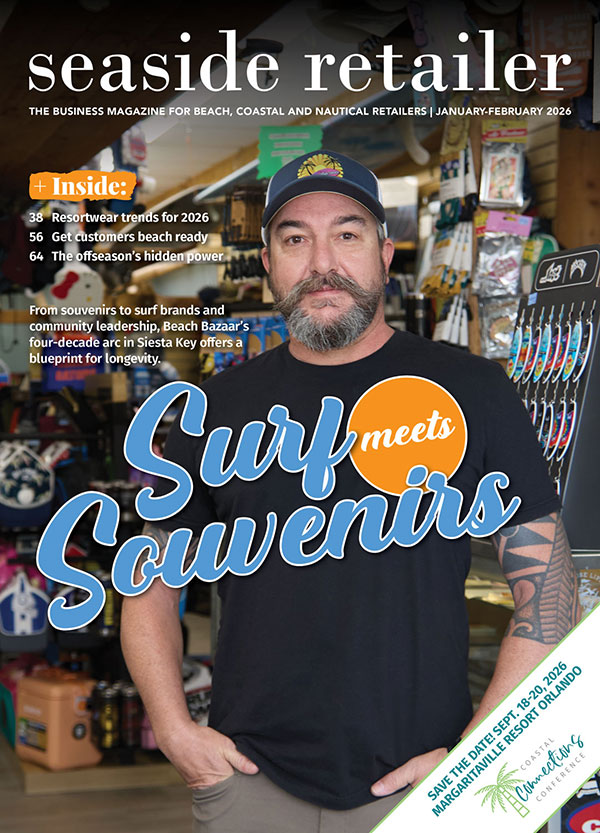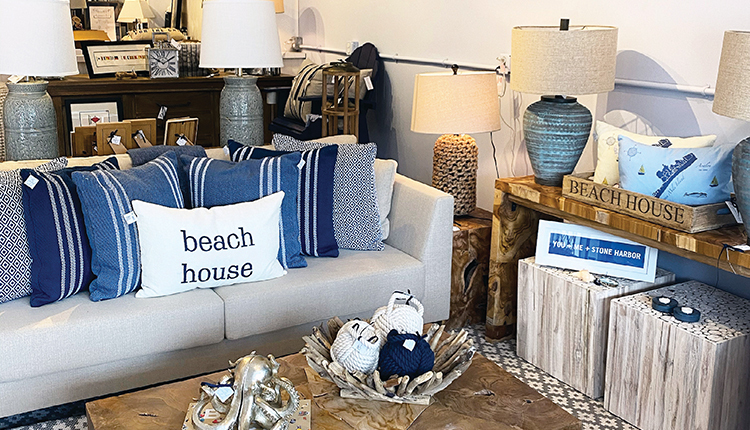
The past year has created an interesting demand for beach, coastal and nautical decor. Stuck at home, many people decorated their homes with art and color palettes reminiscent of the vacations they longed to take. Now that they are able to return to their favorite seaside destinations, they’re eager to splurge on items that remind them of the beach.
By embracing the latest trends in wall art, tableware, linens and other home decor segments, stores can inspire these sea-seeking shoppers to recreate the beach experience at home. 2021’s version of coastal, beach and nautical decor trends incorporates some new inspiration combined with tried-and-true styles that keep their relevance year after year.
Inspired by nature
Natural materials and earthy hues inspired by the sea make it easy for consumers to bring calming beach vibes into their homes.Ember Roberts, co-owner of High Tide Home Provisions in Wilmington, North Carolina, has noticed a big shift toward more of a Bohemian look in coastal decor in 2021. She owns the sea-inspired home furnishings store with her business partner, Amy Fisher.
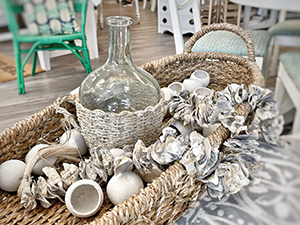
“A lot of people think ‘beach’ and they think bright blues and greens and big crabs and mermaids, but it’s really gone away from that and more toward a subtle Boho vibe,” Roberts says.
This simple style is defined by natural materials like wicker, rattan, seagrass and natural wood. Although most of High Tide’s rehabbed wooden furniture is painted, the color palettes veer toward neutrals and subdued pastels, compared to the bright blues of the past.
That trend expands the coasts. “We’re seeing a lot of neutrals,” agrees Michele Gray, who owns Warehouse 10 in Rockaway Beach, Oregon, with her husband, David. “Natural wood is really popular, especially light wood that’s been whitewashed.”
Because the Grays like to have a variety of textures in the store, they incorporate woven seagrass baskets and wood items with canvas art and metal art. They create the metal pieces themselves, which are popular sellers.
Fashioned into sea-inspired shapes like starfish, sand dollars and compasses (which “fly out of the store,” according to Gray), the pieces are rusted and finished with a light green or aqua patina for a “rustic coastal look.”
Located inside an old 6,000-square foot lumberyard, Warehouse 10 sells coastal decor on one side of the store and modern farmhouse accessories on the other. Gray sees the two styles blending to create vintage-inspired coastal trends centered around chippy paint, rusty metal, faint aquas and pale greens.
A great example of this blending of styles comes from a local artist who paints seascapes on vintage windowpanes, bringing rustic farmhouse chic to the beach.
“Mixing that old vintage style in with the new is very on-trend right now,” Gray emphasizes.
Unexpected accents
Although the typical blues, greens, aquamarines and sandy neutrals will always have a place in coastal decor, home furnishings trendwatcher Julie Smith Vincenti forecasts rainbows ahead for beach retailers. This could take the form of unexpected accents of pastel pink, golden yellow or terra cotta orange alongside traditional beach tones.“We’re seeing rainbow palettes that incorporate more intense colors and color combinations that venture outside of what might be considered safe in some regions,” says Vincenti, who serves as editorial director and creative director at Nine Muses Media, and curates home furnishings trends for IMC programs, including High Point Market’s TrendWatch and Las Vegas Market’s First Look.
For seaside retailers, that means adding “cheery colors like yellow or orange” to complement beachy blues. “These bright colors can go a long way to entice the shopper in — even if, ultimately, that shopper settles on [a more] familiar palette,” Vincenti says.
It’s bold splashes of color draw shoppers into The Spotted Whale, a coastal home decor boutique with four locations on the Jersey Shore.
“People love to see the bright colors,” says owner Ann Pecora. “At the beginning of the season, we always bring in the lime greens, oranges, and hot pinks — but we limit it, because we don’t sell a lot of it.”
At the end of the day, she says the main color palette people actually buy is always “navy blue, beige and a little bit of soft turquoise.”
Bolder colors need to be eased into. Vincenti encourages retailers to explore stripes as a trendy way to incorporate unconventional colors into the expected coastal palettes.
Customized to your local coast
P. Graham Dunn’s beach-inspired sentiments and sayings are always popular. But sales for certain icons from the Dalton, Ohio-based home decor, art, and gift manufacturer’s coastal collection vary by region.“Up toward the Northeast, that’s where we’re seeing navy blues and nautical icons like lighthouses, anchors, blue crabs and compasses. It’s reflective of what’s in that area,” says Anthony Burdette, vice president of marketing and product development. “In the Southeast, we see more bright colors, heavy on the beach imagery.”
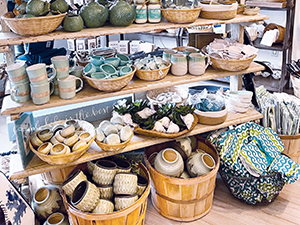
Pecora, who also owns Shard Pottery, a wholesale company known for its coastal tabletop collection, notices the regional nuances as well. “As you move down the lower Mid-Atlantic into Florida, then you transition into seashells, surfboards, turtles, and seagulls,” she says.The seagull mug is one of Shard’s top-sellers so far this year — perhaps at least partly due to the trendy gray shades featured in this pattern. Ultimate Gray was one of 2021’s Pantone Colors of the Year, along with a deep yellow shade called Illuminating.
Oysters and nautical birds like pelicans, pipers and herons are equally popular at High Tide in North Carolina, where Roberts sees the lure of whimsical icons like mermaids starting to fade. Customers want “more natural things that you’d actually see at the beach,” she says.
Since preferences for specific imagery can vary from coast to coast, seaside retailers can look to local sea life and nearby landmarks for product inspiration. For example, Shard added new designs to its collection this year featuring lighthouses in Michigan, Cape Cod, the Outer Banks and New Jersey. “We sell a lot of those [at The Spotted Whale] because our lighthouse is on it,” Pecora says.
When curating and creating products for Warehouse 10, Gray says she focuses on “West Coast sea animals and what’s unique to our area.” Whales and crabs are familiar icons, but not nearly as popular as specific local landmarks.
“We have a famous rock formation called Twin Rocks close to the beach, so we have local artists who do paintings, posters and trinket dishes with the imagery of those Twin Rocks,” Gray says. “People want to bring something home that represents the area, so focus on what tourists and locals are looking for, why they’re coming to that area, and then incorporate those landmarks into pieces of home decor.”
Customization can make products more relevant — turning generic coastal decor into personalized keepsakes. Custom wood signs continue to sell well at High Tide. “They’re really popular for weddings, with the last name, date or longitude and latitude,” says Roberts, who paints the signs herself. “People want something unique.”
P. Graham Dunn launched a customization program about three years ago and continues to see strong demand for this service.
“The big reason a lot of our independent gift shops are leaning that way is because you can differentiate yourself from the big box retailers,” Burdette says. “Small stores can offer things that are more curated and customized — items that actually name drop Myrtle Beach or Clearwater, Florida. People want that memory and to support local, whether they’re from there or they vacation there.”
Pent-Up Demand for Decor
Despite the uncertainty of 2020, many seaside retailers reported strong sales as consumers escaped to domestic vacation spots, hunkered down in beach homes or redecorated to bring coastal vibes inside in lieu of traveling.“Business has skyrocketed” at High Tide since moving to a new retail location in March 2020, shutting down just a couple weeks later due to COVID and then reopening again last May.
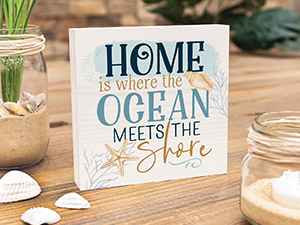
“Manufacturing is so skewed right now, and shipping — especially from overseas — is a costly nightmare,” Pecora says. “If you’re waiting ’til now to order, you’re out of luck, and I don’t see that improving until almost next year.”
Roberts says some furniture stores near High Tide are more than 30 weeks out on custom orders, so her customers appreciate being able to take one-of-a-kind items home instantly. Gray, likewise, feels fortunate to have adequate warehouse space for overstock products, including many items she makes herself.Preparing for the future
As the demand for beach decor continues to rise, the secret to surviving product shortages and shipping delays is to think ahead and purchase in advance.“A lot of independent retailers are stocking up because they’re concerned that if they don’t get it now, vendors may not be able to keep shipping through the fourth quarter,” Burdette says.
By preparing for the holiday shopping season now, retailers can get out ahead of this demand to keep products stocked as customers return to their regularly scheduled vacations and celebrations.
“The wise retailers are also going to create experiences in their stores to remind these vacationers that they haven’t celebrated with their families for a long while. Encourage those vacationers to shop for their friends and family members in anticipation of the holiday gift giving season,” advises Vincenti.
Regardless of the shopping season, regional trends, or personal style preferences, coastal decor will always have a place in people’s homes as they look for ways to bring beach vibes inside all year long.
“The classic coastal style is so timeless that it has stayed consistent, whether there’s a pandemic or not,” Gray says. “Coastal decor is soothing and relaxing, and people decorate their homes in a coastal style because they want that feeling when they go home.”




